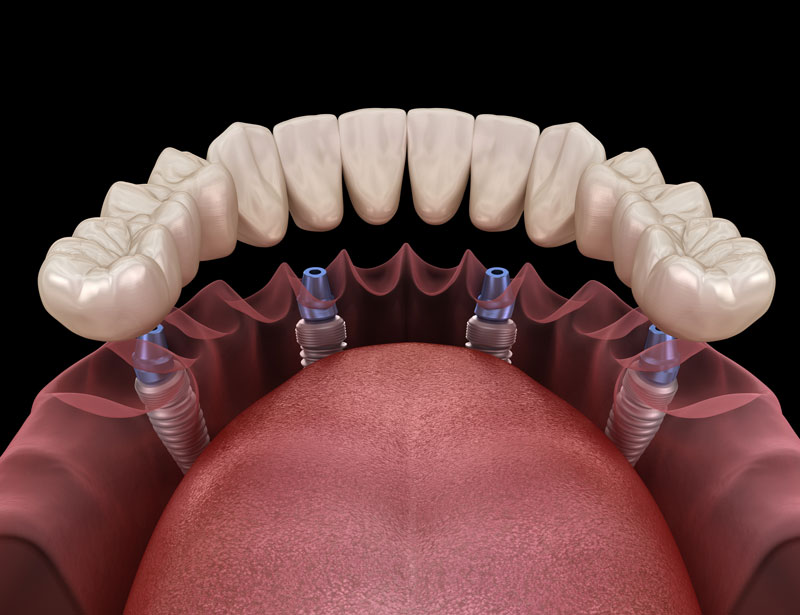A full mouth of implants replaces most or all teeth with dental implants that support a fixed or removable prosthesis. This option helps people who struggle with loose dentures, broken teeth, or major tooth loss. Main benefits include strong bite force for chewing, a natural appearance, and long-term stability compared with removable dentures.
What is a full mouth of implants?
A full mouth of implants means using dental implants to restore an entire upper arch, lower arch, or both. Common approaches include:
- All-on-4 or All-on-6 — a full-arch prosthesis supported by 4 or 6 implants
- Implant-supported dentures — a removable or snap-in denture anchored to multiple implants
- Individual implants with crowns — many single implants each replacing a missing tooth
Compared with traditional removable dentures, implants offer better stability, preserve jaw bone by stimulating it, and improve chewing and speech. Dentures sit on the gums and can shift, while implants integrate with bone to feel more like natural teeth.
Who is a candidate for a full mouth of implants?
Good candidates typically have lost most or all of their teeth, are in generally good health, and have enough jaw bone — or are willing to have bone grafting to build support. Age alone is not a barrier.
Factors that may affect candidacy:
- Uncontrolled diabetes or other medical conditions that impair healing
- Heavy smoking, which raises the risk of implant failure
- Certain medications such as bisphosphonates or strong immunosuppressants
- History of head/neck radiation therapy
Typical evaluation steps:
- Clinical exam of teeth, gums, and bite
- Dental X-rays and CBCT 3D imaging to evaluate bone and anatomy
- Medical history review and discussion of medications
- Treatment planning consultation with options and timelines
The full mouth of implants process — timeline, recovery, and risks
Consultation and planning
Treatment begins with a consultation. The team takes digital scans, CBCT images, and photos. A surgical guide may be planned using 3D software to place implants precisely. You’ll also plan tooth shade, shape, and how your bite will work. From consult to surgery can take a few weeks for planning and lab work.
Surgical stages and temporary teeth
Surgery involves placing implants into the jaw. Options include immediate loading (temporary teeth placed the same day) or delayed loading (temporaries after initial healing). All-on-4/6 surgeries place implants at strategic angles to use available bone and often allow a fixed temporary prosthesis the same day. Final prostheses are delivered after healing and adjustments.
Osseointegration and final restoration
Osseointegration is the process where bone grows around the implant. This often takes 3–6 months depending on location and bone quality. During follow-ups, the dentist checks healing and stability. Once integration is strong, the team moves from a temporary to a final prosthesis made of stronger materials for long-term function.
Recovery and aftercare
Expect swelling and mild to moderate discomfort for 2–4 days, with the peak in the first 48–72 hours. Pain is usually managed with prescribed or over-the-counter medication. Short-term diet is soft foods for 1–2 weeks, progressing as comfort allows. Daily oral hygiene includes careful brushing, cleaning under dentures or prostheses as directed, and regular dental checkups. Typical follow-up visits occur at 1 week, 2 weeks, 3 months, and at final restoration, with annual reviews after that.
Risks and how they’re managed
Common risks include infection, implant failure, and possible nerve or sinus complications. Careful planning with CBCT, proper surgical technique, antibiotics when indicated, and close follow-up reduce these risks. If complications occur, early detection and treatment improve outcomes.
Costs, financing, and choosing a provider for a full mouth of implants
What affects the cost
Costs vary based on the number of implants, need for bone grafts or sinus lifts, type of prosthesis (fixed vs removable), implant brand and materials, anesthesia type, imaging, and lab fees. Fixed, all-ceramic full-arch prostheses cost more than removable implant-supported dentures.
Paying for treatment
Many plans help pay for implant care. Options include partial dental insurance coverage, third-party financing or medical loans, in-office payment plans, and personal savings. The practice can often explain payment options and help find a plan that fits your budget.
How to choose the right provider
Look for a provider with strong implant experience and credentials. Ask for before-and-after photos, check that they use 3D imaging and guided surgery, and request a clear written treatment plan with timelines and costs. A good team will discuss risks and alternatives honestly and answer your questions.
Next steps and brief practice note
If you think a full mouth of implants might be right for you, schedule an initial consultation to review your health, images, and options. Our clinic offers consultations, CBCT 3D imaging, and flexible financing options to help you plan care. Contact the office to arrange an evaluation and get a clear path forward for restoring your smile.

